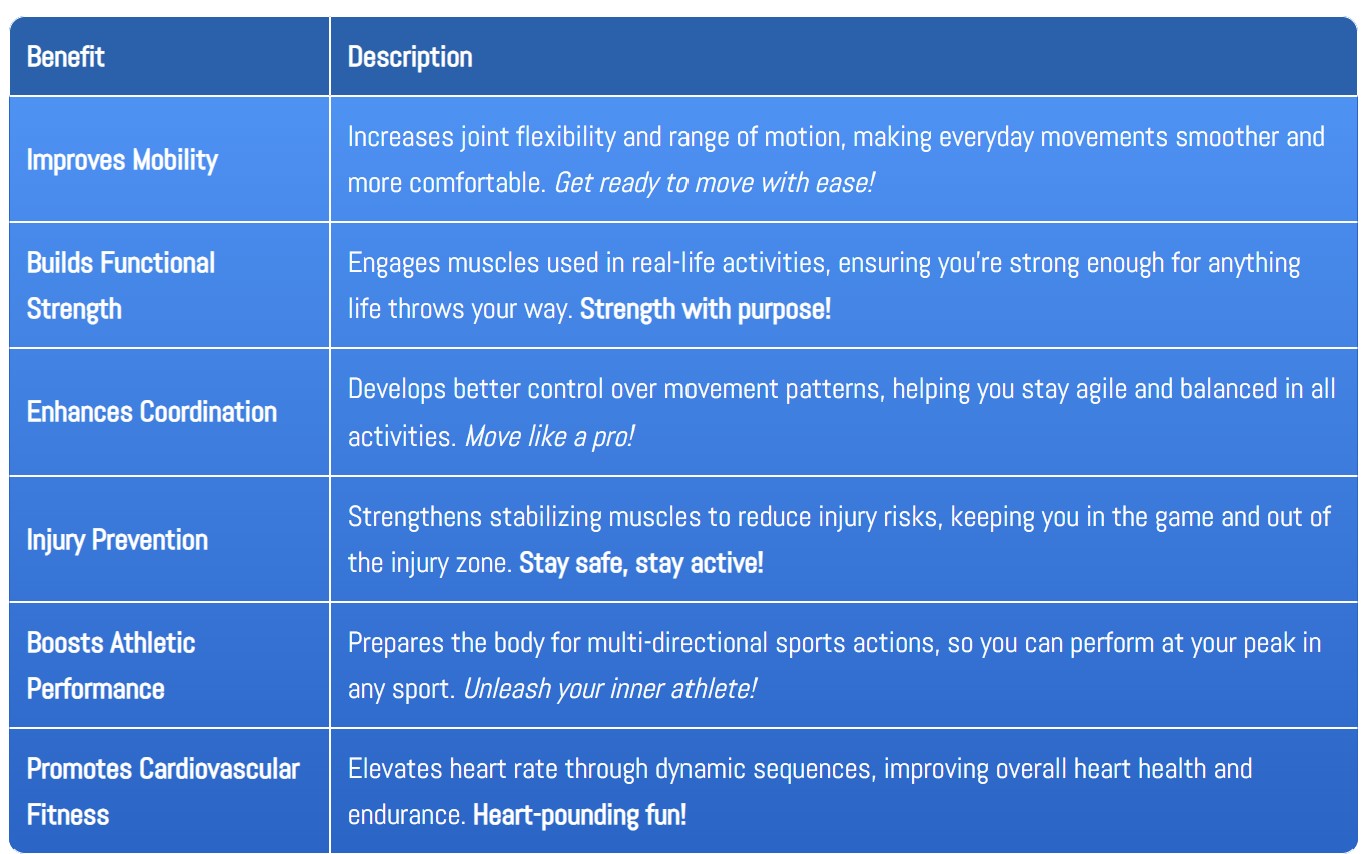Dynamic Movement Patterns: A Key to Functional Fitness
Dynamic movement patterns refer to multi-directional exercises that mimic real-world physical actions, engaging multiple muscle groups and improving mobility, coordination, and functional strength. Below is a detailed breakdown of their benefits, practical examples, and expert tips to help you incorporate these patterns effectively into your fitness routine.
Key Benefits of Dynamic Movement Patterns
| Benefit |
Description |
| Improves Mobility |
Increases joint flexibility and range of motion. |
| Builds Functional Strength |
Engages muscles used in real-life activities. |
| Enhances Coordination |
Develops better control over complex movements. |
| Injury Prevention |
Strengthens stabilizing muscles to reduce injury risk. |
| Boosts Athletic Performance |
Prepares the body for sport-specific actions. |
| Promotes Cardiovascular Fitness |
Elevates heart rate through dynamic sequences. |
Types of Dynamic Movement Patterns
| Movement Type |
Description |
Examples |
| Multi-Planar Movements |
Involves movement across multiple planes (sagittal, frontal, transverse). |
Walking lunges, side shuffles |
| Explosive Movements |
Focus on speed and power. |
Box jumps, burpees, sprints |
| Rotational Movements |
Incorporates twisting motions to improve core stability. |
Russian twists, medicine ball slams |
| Balance and Stability Drills |
Develop smaller stabilizing muscles. |
Single-leg deadlifts, BOSU squats |
| Plyometric Patterns |
High-intensity jumping movements. |
Jump squats, clap push-ups |
Dynamic vs. Static Movements
| Dynamic Movements |
Static Movements |
| Movement across a range of joints |
Minimal motion, holding positions. |
| Enhances mobility, strength, and coordination |
Builds endurance and stability. |
| Used in warm-ups and sports drills |
Common in yoga and stretching routines. |
| Engages multiple muscle groups |
Targets isolated muscles. |
How to Incorporate Dynamic Patterns into Your Workout
- Warm-Up Routine: Activate your muscles with dynamic stretches, such as leg swings and walking lunges.
- Circuit Training: Alternate between lower and upper-body movements to maintain heart rate and increase endurance.
- Skill Development: Use agility drills like lateral bounds or ladder runs to improve speed and coordination.
- Progressive Overload: Gradually increase reps or weight to ensure long-term improvement.
Examples of Dynamic Movement Exercises
| Exercise |
Target Muscles |
Purpose |
| Walking Lunges |
Quadriceps, glutes, hamstrings |
Improves lower body strength and balance. |
| Kettlebell Swings |
Hamstrings, glutes, core |
Builds explosive hip power. |
| Medicine Ball Slams |
Core, shoulders |
Enhances rotational strength. |
| Lateral Bounds |
Glutes, calves, core |
Develops agility and lateral power. |
| Bear Crawls |
Core, shoulders, quads |
Improves full-body coordination. |
Q&A: Your Questions Answered
Q1: What makes dynamic movement patterns different from traditional exercises?
A1: Dynamic patterns simulate real-world actions, engaging multiple muscle groups at once. Unlike isolated exercises, they improve mobility, coordination, and functional strength.
Q2: How often should I incorporate dynamic movements into my routine?
A2: Use them 3–4 times per week, especially in warm-ups or as part of functional training circuits, depending on your fitness goals.
Q3: Can beginners perform dynamic movement exercises?
A3: Yes, but it’s essential to start with simple versions, like bodyweight lunges, before progressing to complex movements such as box jumps.
Q4: What role do dynamic movements play in injury prevention?
A4: They strengthen stabilizing muscles, which improves joint stability and reduces the risk of injury, especially during sports or high-impact activities.
Q5: Do dynamic movement patterns help with weight loss?
A5: Yes, these movements elevate heart rate, burn more calories, and build lean muscle, promoting fat loss when combined with a proper diet.
Q6: Can older adults benefit from dynamic exercises?
A6: Absolutely. Exercises like controlled walking lunges and balance drills enhance mobility and prevent falls, which are crucial for older adults.
Q7: What’s the best way to avoid injury when performing dynamic movements?
A7: Focus on form first, use proper footwear, and incorporate a warm-up and cool-down in your routine to prevent strain and injury.
Q8: How can dynamic movement patterns improve sports performance?
A8: They enhance agility, coordination, and functional strength, which translates to better performance in sports that involve multi-directional movement, such as soccer, tennis, and basketball.
Q9: What’s the difference between explosive and rotational dynamic movements?
A9: Explosive movements focus on power and speed, like box jumps, while rotational movements, like medicine ball slams, develop core strength and stability.
Q10: How do I know if I’m performing these movements correctly?
A10: Pay attention to your body’s alignment and balance. If possible, work with a trainer or use mirrors to monitor your form.

